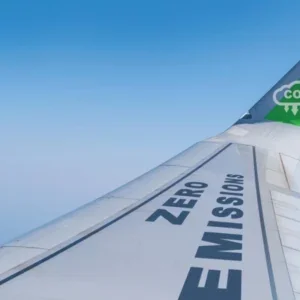Future Airport: What is SESAR and why was it set up?
Nicholas Warinsko: Aviation is an engine of economic growth in Europe and air traffic management (ATM) plays an essential part of European aviation. However, Europe’s ATM system is based on ageing technology and procedures, and needs updating, particularly considering the expected traffic growth between now and 2035. This is where SESAR comes in. The aviation industry employs around 1.4 million people and supports between 4.8 million and 5.5 million jobs. It contributes an overall impact of €110 billion to the EU’s GDP. By 2035, we expect to see 14.4 million flights carrying 1.4 billion passengers. The Single European Sky ATM Research (SESAR) is the technological pillar of this Single European Sky (SES) policy. It aims to improve ATM performance by modernising and harmonising ATM systems through the definition, development, validation and deployment of innovative technological and operational solutions. Deployment of these SESAR solutions across Europe helps ensure the region’s aviation industry and economy can grow safely and sustainably.
In 2007, the SESAR joint undertaking (SJU) was set up, and focused on researching and developing the operational concepts and technologies required to enable this breakthrough. Since 2015, SESAR is also in its deployment phase – delivering into the everyday operations of airlines, airports and air navigation service providers the validated SESAR solutions.
What are the key objectives of SESAR?
The SES is an ambitious initiative to remove boundaries in the air, just as they were removed on the ground for the single market. The SES goal is to reform the architecture of European air traffic control to meet future capacity and safety needs, in particular, by improving the overall performance of ATM and air navigation. To fulfil these SES objectives, the European Commission set the following high-level goals: enabling a three-fold increase in capacity that will also reduce delays on the ground and in the air; improving safety by a factor of ten; enabling a 10% reduction in the effects flights have on the environment; and providing ATM services to the airspace users at a cost of at least 50% less.
SESAR’s goal is to define, develop, validate and deploy innovative technologies and operational procedures – known as the SESAR solutions – needed to contribute to increase the performance of Europe’s ATM system to reach these objectives. SESAR consists of three main phases.
The definition phase includes the European ATM master plan, the roadmap for driving the European ATM modernisation programme, managed by the SJU. It sets out the necessary steps involved for the development and deployment of solutions with technology and operational procedures, linking them to the SES performance objectives, and ensuring global interoperability and consistency with the ICAO Global Air Navigation Plan.
The development phase involves the SJU, created at the end of 2007, which is responsible for the modernisation of the European ATM system by coordinating and concentrating all relevant research and development efforts. It is a public-private partnership between the main public and industrial stakeholders.
Finally, the deployment phase includes the SESAR deployment manager (SDM), which is responsible for the management level of the SESAR deployment governance, for the coordination of the implementation of the EU’s Common Projects, based on solutions to be deployed in a synchronised and timely manner across Europe. SDM is an EU-funded industry consortium, composed of and working for, the industry. The consortium members, mandated by the European Commission, are major ATM operational stakeholders in Europe. That way, Europe’s largest ANSPs, all major airlines and the Airports Grouping, representing the 24 major airports in Europe, are represented. This set-up gives strength through the knowledge base of members.
The Commission has established the policy level of the SESAR deployment governance. The first tasks addressed at this level were the development of the Common Project and the set-up of the deployment manager. The work on both tasks ran in parallel; however, the intention was to adopt a first common project that will serve as a concrete basis on which the relevant operational stakeholders can set up the partnership, including the deployment manager and develop the deployment programme to implement it.
What progress has SESAR made so far?
To date, 42 implementing projects under SDM coordination have been completed. According to the plan, 31 more projects should be completed by the end of 2017, significantly raising the frequency and volume of SDM and implementing partners’ delivery. In summer 2017, about 20% of the Pilot Common Project (PCP) was already implemented and 50% is currently being implemented.
The increasing number of completed projects leads SDM to extend its performance monitoring from “expected contribution” to also address “actual contribution”. In total, the portfolio of the SDM on implementation projects today represents a total investment of €2.46 billion. When delivered, this will result in a reduction of 275 million minutes (a reduction of more than 50% of reduction compared with today) and 10 million tons of CO2 saved (10,000km2 of forest) by 2030. These figures demonstrate the ability of SESAR to deliver and leverage the planning, monitoring and synchronisation tasks of the SDM, rolling out the SJU R&D into operational reality.
Less than three years after the establishment of the SDM, these figures demonstrate the reality of SESAR deployment as well as the buy-in of the stakeholders: 295 projects from 84 implementing partners in 33 countries for an investment of €2.46 billion. The EU facilitates those investments through grants, currently totalling close to €1.4 billion.
What barriers are standing in the way of SES?
We can only speak for the technological pillar of the SES. There, a prompt detection and effective management of risks is key to ensuring the coordinated, timely, successful and synchronised implementation of the SESAR Deployment Programme.
The risks listed in the SESAR Deployment Programme are well connected and linked to the risks listed in the ATM master plan, especially regarding implementation-related issues.
How can SESAR improve efficiency and enable a reduction in the effects flights have on the environment?
SESAR solutions refer to new or improved operational procedures or technologies that aim to contribute to the modernisation of the European and global ATM system. Each solution includes a range of documentation, including operational services and environment descriptions; safety, performance and interoperability requirements; technical specifications; regulatory recommendations; safety and security assessments; and human and environmental performance reports.
The first edition of the SESAR Solutions catalogue contains 63 solutions, of which 24 are being deployed across Europe simultaneously. Work is under way to implement the solutions in the catalogue. A few of these examples include extended-arrival management, which allows the sequencing of arrival traffic much earlier than is currently the case, allowing smoother traffic management. Heathrow Airport in London has implemented the solution and has already cut holding times in its arrival stacks by one minute, reducing noise emissions and saving airlines over €2 million in fuel bills and 7,500 tons of carbon dioxide annually. The solution, which is part of synchronised deployment plans, has already been implemented in seven other locations in Europe.
Another example is allowing an aircraft to freely plan its route, optimising its respective heights, in line with individual operator business needs and military requirements. Around 25% of the European network has implemented steps towards free-routing areas. Flying distances are reduced by approximately 7.5 million nautical miles, representing the equivalent of 45,000t in fuel savings, reduced emissions of 150,000t or €37 million.
What challenges lie ahead for the SES project?
The EU’s main objective is to reform ATM in Europe to cope with sustained air traffic growth and operations under the safest, most cost and flight-efficient and environmentally friendly conditions.
Significant achievements have already been booked at an operational and technological level.
Member states should do their best to maximise the benefits of activities initiated under the present SES regulation, reinforcing the institutional framework starting from the final approval of the SES 2 plus regulation.






